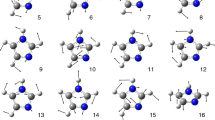Abstract
The complexes Mn(II), Co(II), Ni(II) and Zn(II) with 4-oxo-4H-1-benzopyran-3-carboxaldehyde were synthesized and characterized by elemental analysis, infrared and UV spectroscopy, X-ray diffraction patterns, magnetic susceptibility, thermal gravimetric analysis, conductivity and also solubility measurements in water, methanol and DMF solution at 298 K. They are polycrystalline compounds with various formula and different ratio of metal ion:ligand. Their formula are following: [MnL2(H2O)](NO3)2·2H2O, [CoL2](NO3)2·3H2O, [NiL2](NO3)2·3H2O, [CuL2](NO3)2·H2O and [ZnL3](NO3)2, where L = C10H6O3. The coordination of metal ions is through oxygen atoms present in 4-position of γ-pyrone ring and of aldehyde group of ligand. Chelates of Mn(II), Co(II), Ni(II) and Cu(II) obey Curie–Weiss law and they are high-spin complexes with the weak ligand fields. The thermal stability of analyzed complexes was studied in air at 293–1,173 K. On the basis of the thermoanalytical curves, it appears that thermal stability of anhydrous analysed chelates changed following: Cu (423 K) < Zn (438 K) ~ Co (440 K) < Ni (468 K). The gaseous products of thermal decomposition of those compounds in air atmosphere are following: CO2, CO, NO2, N2O, hydrocarbons and in case of hydrates also water. The molar conductance data confirm that the all studied complexes are 1:2 electrolytes in DMF solution.





Similar content being viewed by others
References
Youssef TA, Ramadan MA, Khalifa AA. Acetophenones, a chalcone, a chromone and flavonoids from pancratium maritimum. Phytochemistry. 1998;8(49):2579–83.
Gao H, Wu L, Kuroyanagi M. A new compound from Chaenomeles sinensis (Thain) Koehne. Chinese Chem Lett. 2003;14(3):274–5.
Tanaka H, Hirata M, Etoh H, Shimizu H, Sako M, Murata J, Murata H, Darnaedi D, Fukai T. Eryvarins F and G, two 3-phenoxychromones from the roots of Erythrina veriegata. Phytochemistry. 2003; 62:1243–1246.
Walenzyk T, Carola Ch, Buchholz H, König B. Chromone derivatives which bind to human hair. Tetrahedron. 2005;61:7366–77.
Sherif OE, Abd El-Fattah HM, El-Ajily MM. Characterization of transition metal ion chelates with 8-(arylazo)chromones using thermal and spectral techniques. J Therm Anal Calorim. 2003;74:181–200.
Arjunan V, Subramanian S, Mohan S. FTIR and FTR spectral studies of 2-amino-6-bromo- 3-formylchromone. Spectrochim Acta. 2004;A60:995–1000.
Budzisz E, Małecka M, Woźniczka M, Kufelnicki A. Crystal structure, protolytic properties and alcylating activity of 3-(1-amino-ethylidene)-2-methoxy-2-oxo-2, 3-dihydro-2λ5-benzo[e][1, 2]oxophosphinin-4-one. J Mol Struct. 2005;753:113–8.
König E. Magnetic properties of coordination and organometallic transition metal compounds. Berlin: Springer-Verlag; 1966.
Socrates G. Infrared and Raman characteristic group frequencies. Chichester: John Wiley&Sons; 2001.
Zhong GQ, Shen J, Jiang QY, Jia YQ, Chen MJ, Zhang ZP. Synthesis, characterization and thermal decomposition of Sb(III)-M-Sb(III) type trinuclear complexes of ethylenediamine-N, N, N′, N′-tetraacetate (M:Co(II), La(III), Nd(III), Dy(III)). J Therm Anal Calorim. 2008;2(92):607–16.
Olar R, Badea M, Grecu MN, Marinescu D, Lazar V, Balotescu C. Copper(II) complexes with N, N-dimethylbiguanide. Thermal, spectroscopic and biological characterization. J Therm Anal Calorim. 2008;1(92):239–43.
Nakamoto K. Infrared and Raman spectra of inorganic and coordination compounds. Toronto: Wiley; 1997.
Vlad M, Labadi I, Saity L, Tudose R, Linert W, Costinor O. Synthesis, characterization and thermal properties of [Cu(VO)2(C2O4)3(4, 4′-bpy)2·2H2O]A 2D polymer. J Therm Anal Calorim. 2008;3(91):925–8.
Zieliński W, Rajca A. Spectroscopic methods and their applications for the organic compound identifications. Warsaw: Scientific and Technical Publisher; 2000.
Patel SH, Pansuriya PB, Chhasatia MR, Parekh HM, Patel MN. Coordination chain polymeric assemblies of trivalent lanthanides with multidentate Schiff base synthetic, spectral investigation and thermal aspects. J Therm Anal Calorim. 2008;2(91):413–8.
Donia AM, El-Boraey EA, El-Samalehy MF. Thermal investigation of iron(III) and manganese (II, III) complexes of dianils derived from 6-formylkhellin. J Therm Anal Calorim. 2003;73:987–1000.
Youssef NS, Hegab KH, Eid AE. Synthesis and coordinating properties of new chromone thiosemicarbazone towards some transition metal ions. Synth React Inorg Met-Org Chem. 2003;9(33):1647–66.
Budzisz E, Małecka M, Nawrot B. Synthesis and structure of highly substituted pyrazole ligands and their complexes with platinum(II) and palladium(II) metal ions. Tetrahedron. 2004;60:1749–59.
Lazaraou K, Psycharis V, Perlepes S, Raptopoulou C. Complexes derived from the copper(II) perchlorate/maleanic acid/2, 2′-bipyridine and copper(II) perchlorate/maleic acid/2, 2′-bipyridine reaction systems: synthetic, reactivity, structural and spectroscopic studies. Polyhedron. 2009;28:1085–96.
Yesilel OZ, Olmez H, Icbudak H. Orotic acid complexes of Co(II), Ni(II), Zn(II) and Cd(II) with imidazole. Synthesis, spectroscopic and thermal studies. J Therm Anal Calorim. 2007;2(89):555–9.
Thakurta S, Roy P, Rosair G, Gomez-Garcia C, Garribban E, Mitra S. Ferromagnetic exchange coupling in a new bis(μ-chloro-)bridged copper(II) Schiff base complex: synthesis, structure, magnetic properties and catalytic oxidation of cycloalkanes. Polyhedron. 2009;28:695–702.
Yesilel O, Mutlu A, Buyukgungor O. Novel dinuclear and polynuclear copper(II) supramolecular complexes with 1, 3-propanediamine N, N, N′, N′-tetramethylethylenediamine and 2, 2′-bipyridine. Polyhedron. 2009;28:437–44.
Bridson AK. Inorganic spectroscopic methods. New York: Oxford University Press; 1988.
Harwood LM, Claridge TD. Introduction to organic spectroscopy. New York: Oxford University Press; 1999.
Łągiewka E, Bojarski Z. X-ray structural analysis. Warsaw: Polish Scientific Publisher; 1988.
Nikolaev AV, Logvienko VA, Myachina LJ. Thermal analysis, vol. 2. New York: Academic Press; 1989.
Paulik F. Special trends in thermal analysis. Chichester: Wiley; 1995.
O′Connor CI. Progress in inorganic chemistry. New York: Wiley; 1982.
Cui S, Zhao Y, Zhang J, Liu Q, Zhang Y. Structural and magnetic properties of metal complexes with pyridine-2, 6-dicarboxylate and 5-(4-bromophenyl)-2, 4′-bipyridine. Polyhedron. 2009;28:980–6.
Ferenc W, Walków-Dziewulska A, Wojciechowska M, Sarzyński J. Thermal, spectral and magnetic characterization of Co(II), Ni(II) and Cu(II) 4-chloro-2-nitrobenzoates. J Therm Anal Calorim. 2006;2(86):359–64.
Geary W. The use of conductivity measurements in organic solvents for the characterization of coordination compounds. J Coord Chem Rev. 1971;7:81–122.
Hamman AM, Ibrahim SA, El-Gahami MA, Fouad D. Investigations of Co(II), Ni(II) and Cu(II) (2, 2′:6′, 2″-terpyridine)complexes with sulphur donor ligands. J Therm Anal Calorim. 2003;74:801–10.
Chandra S, Gupta LK, Jain D. Spectroscopic studies on Mn(II), Co(II), Ni(II) and Cu(II) complexes with N-donor tetradentate (N4) macrocyclic ligand derived from ethylcinnamate moiety. Spectrochim Acta. 2004;A60:2411–7.
Author information
Authors and Affiliations
Corresponding author
Rights and permissions
About this article
Cite this article
Dziewulska-Kułaczkowska, A. Manganese(II), cobalt(II), nickel(II), copper(II) and zinc(II) complexes with 4-oxo-4H-1-benzopyran-3-carboxaldehyde. J Therm Anal Calorim 101, 1019–1026 (2010). https://doi.org/10.1007/s10973-009-0605-3
Received:
Accepted:
Published:
Issue Date:
DOI: https://doi.org/10.1007/s10973-009-0605-3




